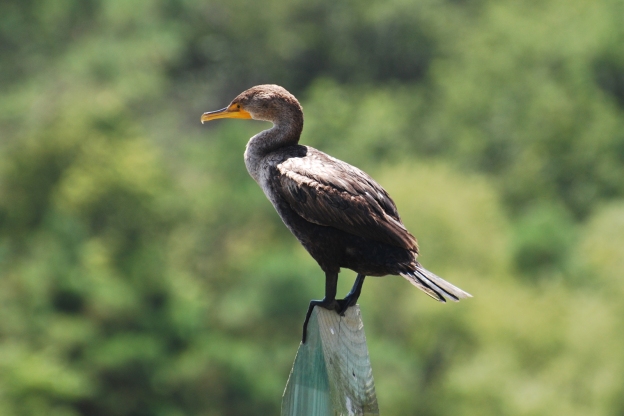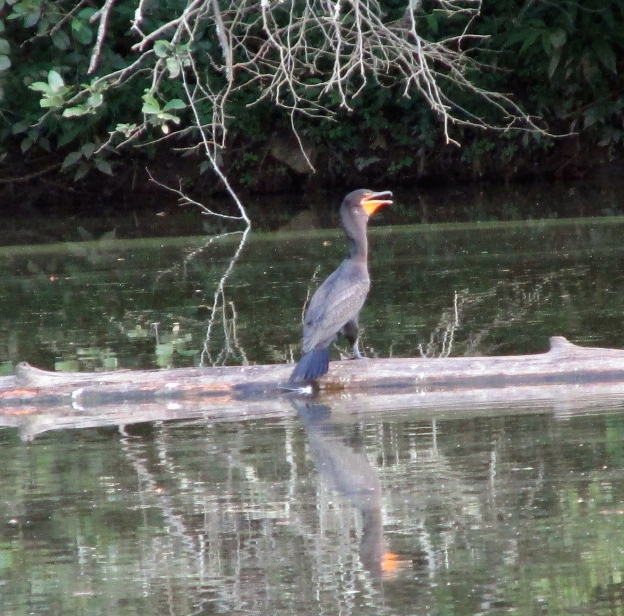
Photo by Rodney Krey/U.S. Fish & Wildlife Service • The double-crested cormorant is a water bird designed for preying on fish. The population of this cormorant has increased in recent years.
For those interested in learning to identify the birds they see during trips or that show up in their gardens or yards, a good field guide is an indispensable tool. But for whatever the reason, I’ve got to add a slight caveat to my recommendation to obtain a field guide for bird identification help: The range maps in many of our field guides are in need of a good update.
As a case in point, I recent received an email from reader Beth Webb, who had a question about an observation she made recently.
“While at South Holston Lake this weekend, I saw about 12 or 18 birds in a tree,” Beth wrote. “I could not identify them.”
She noted that her binoculars were not the best and the boat was rocking. Nevertheless, she had an idea on the identity of the perched birds.
“They had the silhouette of a cormorant,” Beth wrote. “My field guide is older and it does not place cormorants in this area, but I am wondering if they have been sighted here.”
Beth added that several years ago she saw a cormorant at South Holston Lake and was able to watch it dive in one spot and come up several seconds later in another.

Photo courtesy of Sandy Loving • This photo taken on June 14, 2019, probably shows some of the same cormorants that Beth Webb saw on South Holston Lake.
I emailed Beth back an answer to her query, telling her that double-crested cormorants have not always been a common bird in our region. For the past couple of decades, their numbers have been increasing nationwide, not just in our region.
The fact that she saw so many of them in a single tree makes me think she probably came close to a nesting rookery. Cormorants often nest near wading birds like great blue herons, which are also known to nest at South Holston Lake.
So, even with a rocking boat, Beth did a great job identifying the cormorants. Beth’s observation points out a weakness in some field guides. Birds are not static creatures. They have the power of flight and are constantly using that ability to expand into new places, Publishers of bird identification field guides are often challenged to keep pace.
For instance, the region’s birders birding in the 1970s would have considered the now ubiquitous Canada goose a rare bird. Before the 1980s, the tree swallow hardly ever nested in the region. Another swallow – the cliff swallow – has abandoned the faces of cliffs to nest beneath concrete bridges and has gone from being a rare swallow in the region to one of the most common summer nesting birds in the entire region in just the last couple of decades. Species ranging from cattle egret to Eurasian collared dove may not appear on the range maps in your guide books, but they can be found in the region.
Most bird identification guides follow a simple format: illustrations (photographs or paintings) that are accompanied by brief, precise text and maps showing a particular bird’s expected range, sometimes delineated by season. Many birds may be absent in summer but present in winter, for instance, so a color-coded range map designating year-round, summer and winter residency is highly desirable.

Photo by Bryan Stevens • Field guides are an essential tool for bird identification, but features such as range maps can quickly go out of date.
A good field guide should also be small enough to be easily carried and consulted in the field. One that slides into a pocket is ideal. Many tech-savvy people are relying on their smart phones as an alternative to a field guide, but the printed page is hard to beat in remote areas where a phone experiences difficulty finding enough signal bars.
Hopefully future field guides will include updates to the range maps that show cormorants do indeed reach Northeast Tennessee and Southwest Virginia.
Two of the field guides that I recommend for beginning birders are the Golden Guide to Birds of North America by Chandler S. Robbins and the Peterson Field Guide to Birds of North America by Roger Tory Peterson.
The cormorants are certainly a bird worth knowing. The double-crested cormorant belongs to a family of 40 birds consisting of species referred to as both cormorants and shags. Some of the world’s other cormorants include the flightless cormorant, black-faced cormorant, white-breasted cormorant, crowned cormorant, little cormorant, pygmy cormorant and the imperial shag, which is also known as the blue-eyed shag.
Besides the double-crested cormorant, North America is home to five other species. The great cormorant lives along the shores of the Atlantic Ocean from Canada down to southern Florida. The pelagic cormorant and the Brandt’s cormorant can be seen along North America’s Pacific coastline. The red-faced cormorant lives in the southern regions of Alaska out into the Aleutian Islands. The most southern of these North American cormorants is the Neotropic cormorant, which is found along the southeast areas of Texas down into Mexico.
All cormorants primarily fish for their meals. They have strong legs to propel them though the water when they dive for fish. They also have a serrated bill with a hooked tip that is excellent for grasping slippery fish.

Photo by Bryan Stevens • A double-crested cormorant rests on a fallen log after a swim in a lake near Atlanta, Georgia.
On the recent Spring Bird Count for Northeast Tennessee conducted by the Lee and Lois Herndon Chapter of Tennessee Ornithological Society, a total of 82 double-crested cormorants were found on area waterways. Those birds provide a good indication that cormorants are now an established species in the region.









